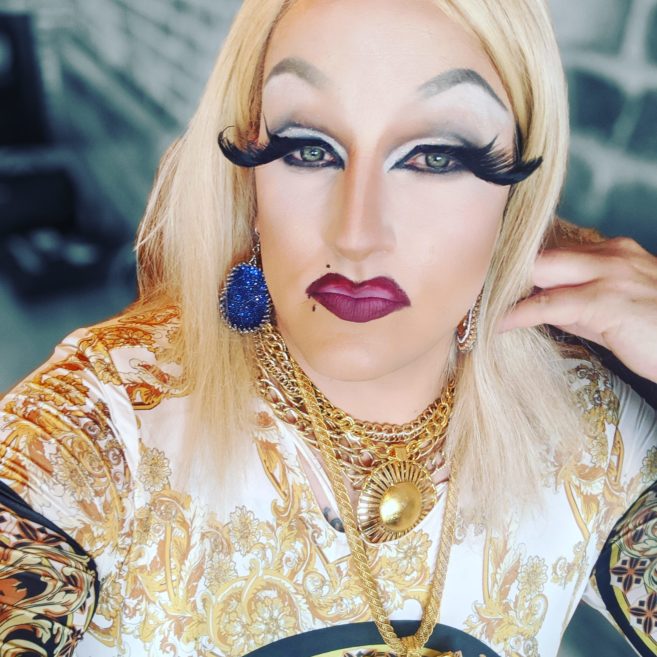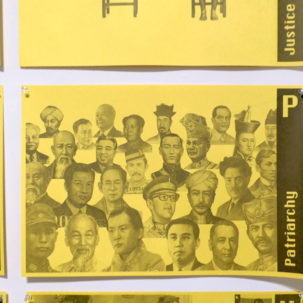In “The Patron and the Crocus,” Virginia Woolf says, “to know whom to write for is to know how to write.”
Chris Kraus’s first novel, I Love Dick (1997), followed this direction. She inadvertently started the book when she began a fervid, almost entirely one-sided letter-writing campaign to an unrequited love (the titular Dick), which she used as a base to talk about French critical theory, Hannah Wilke, labour strikes in Guatemala and, above all, herself.
Ruth Curry, writer, editor and cofounder of Emily Books, has measured the book’s scope succinctly: “In a sense, I Love Dick is about a crush. And Moby Dick is about a whale.”
It was I Love Dick that propelled Kraus into fame. Even if you haven’t read it yet, you’ve likely seen the book’s cover, brandished provocatively on Tumblr or Instagram by the author’s cult following. Or maybe you’ve seen the TV adaptation produced by Transparent creator Jill Soloway, starring Kathryn Hahn and Kevin Bacon.
With I Love Dick‘s growing success, the book has garnered a degree of notoriety. In it, Kraus writes, “I think the sheer fact of women talking, being, paradoxical, inexplicable, flip, self-destructive, but above all else public is the most revolutionary thing in the world.”
There’s divisiveness among those who credit Kraus with opening the door for art that allows women’s experiences to be represented more comprehensively, and those who resent her for granting that permission to a generation of self-indulgent narcissists who didn’t really get the point of her book.
Kraus is ever patient when answering questions about the work that has granted her mainstream appreciation. Of course, she has done so much more. In addition to continuing in her role as editor at Semiotext(e), a publisher of “theory, fiction, madness, economics, satire, sexuality, science fiction, activism and confession,” Kraus manages property, teaches art-writing courses in multiple graduate programs and has authored the books Aliens and Anorexia (2000), Video Green: Los Angeles Art and the Triumph of Nothingness (2004), Torpor (2006), Where Art Belongs (2011) and Summer of Hate (2012).
Her next book, a critical biography of Kathy Acker, comes out in August 2017.
I talked to Kraus on the phone last week. She was in Winnipeg, on the last day of the three-week writing workshop she led at the Plug In Institute of Contemporary Art, joined by writers Natasha Stagg and Robert Dewhurst, as well as a group of 15 graduate students and other arts professionals. She’ll be back in Canada this September, for Contemporary Calgary’s symposium on the future of art writing.
We spoke about her admiration for Acker, her desire to undo the false mythologies that have been created around the New York art scene, why MFAs in art writing are patently ridiculous and why writers should consider the virtues of plagiarism. And for anyone who didn’t attend her Plug In workshop, she provides a tantalizing glimpse at what was on the reading list.
Rosie Prata: I’m interested in learning what’s been produced over the residency. I heard that you’ve been doing writing classes, movement classes, producing a video, going on walks and all sorts of other activities.
Chris Kraus: People came in with some very grandiose ideas about how much could be accomplished in three weeks, and they’ve been scaling down what their projects are going to be. But the accomplishment goes far beyond any kind of product that is shown or read or screened; the accomplishment really is an exchange of ideas and experience over three weeks that hopefully will ripple out in everybody’s work and life in the future.
RP: It’s interesting that you say that, because I was wondering if that was similar to how your biography of Kathy Acker, which is coming out in August via Semiotext(e), came about. You had all these tangential connections to Acker over the years, including publishing her writing at Semiotext(e), that are now being brought together in this book about her life.
CK: I had no personal relationship to Kathy at all, but we knew a lot of people in common. I’m part of many of the same extended artistic families that Acker moved in, or at least I have access to these people, and I felt that there was a book that I was uniquely qualified to write—I’ve been in so many of the same places, and have so many of the same references and know so many of the same people.
Writing about Acker’s life is also a means of writing an alternative history of some of the eras she moved through. New York in the 1970s and ’80s has been so mythologized, the ’90s in San Francisco, as well. A lot of the memoirs and retrospectives about these eras feel false and romanticized. I thought that by tracing the life of one person, it would be possible to give a more realistic depiction of those years in those circles.
RP: What made you want to write a book about Acker in particular?
CK: I admire a lot of her work, and I especially admire her extreme discipline and accomplishment. From Black Tarantula through Great Expectations, Acker was creating a style and a form that hadn’t existed before. It drew from other styles and traditions, but she invented something completely original, important, that powerfully spoke to people at that time and place. And her work was incredibly prescient of ways people are writing today. And her relation to fame, her drive to create a personal mythology are kind of an object lesson that’s very interesting to look at today.
RP: How would you define this style and form that she invented?
CK: She used a very brash, direct, mass-market first-person persona, but beneath that, she was devising compositional strategies that drew a great deal from Conceptual art: the era when all of the artists were reading phenomenology and other philosophy. So, her narrators are talking trash, but within a very complex formal structure!
Acker was one of the most academically brilliant people of her generation. She was formidably informed, through reading and study, and by sleeping with people who knew things she wanted to know. Cannibal Acker.
She was still in her late 20s when she wrote The Childlike Life of the Black Tarantula, which she produced and distributed as a mail-art serial zine. In it, she intercuts excerpts from her own diary with appropriated library texts. Living in Solana Beach with Peter Gordon, she went to the UC San Diego library and dug up long-out-of-print trade books like Lives of Murderesses, and switched the third person to first. Scrambling up the “I” to a point where the “I” is so amplified that it disappears, she very deliberately arranged these two sources within an A/B grid.
The compositional strategy was straight out of Conceptual art, but the final result was alarming: it didn’t have that aura of high seriousness we associate with that work. It was a punch in the gut.
RP: In an interview you did with Fiona Duncan for Ssense, you talked about how Kathy Acker was pressured to push her bad-girl image as a marketing tool to promote her writing. Have you been feeling any similar pressure to inhabit and live up to this iconic status because of the popularity of I Love Dick, or since the renewed attention you’ve received since Jill Soloway’s TV adaptation has come out?
CK: I’ve always been wary of icons, and anything to do with personal mythologies and all of that mystification. It’s a mystification that creates lack, and it was never my goal. Really, my goal was just to have my books read seriously, as literary works, not as a dirty joke. The effect of I Love Dick, I didn’t expect it. But what can you do but embrace it, and try and use it to do something worthwhile? Iconography has a life of its own, and ends up having a lot more to do with people’s projections.
I’m glad I Love Dick has travelled as far as it has, and I appreciate the response, but really I just need to let the “Chris Kraus” of that book go her own way, and get on with what I’m working on now. I try not to take it too personally.
RP: A lot is made of your fan base being made up of young, women-identifying people, but I think this is only the most visible faction, because these are the people who are posting your book cover on social media, and these are also the people with the social freedom for their sexuality to be accepted and “Liked” on a public platform. You wrote I Love Dick when you were 39 or 40, and you’ve written about sex and romantic love and S&M in many of your subsequent books. I am interested in your older fan base, particularly the middle-aged and senior women, and the kind of feedback you get from these groups.
CK: A lot of these middle-aged and older women, at least in the art world, were the original readers of I Love Dick! I think Torpor and Summer of Hate speak more directly to situations that people face in middle age. It’s funny—it’s a more romantic narrative to pretend that I Love Dick was completely vilified or ignored, and then revived in the Internet age—but that isn’t true. The book circulated within the art world then, among a lot of women my age, and their response to it was totally gratifying.
RP: You said soon after I Love Dick first came out that maybe the entire point of publishing the book was to “explod[e] this ‘right of privacy’ that serves patriarchy so well,” and that, “The issue of privacy is to female art what obscenity was to male art of the 1960s.” After your book experienced this resurgence of popularity after its second printing in 2005, there was this ripple effect where women-identifying artists came to feel that they could debase themselves and experience public failure—and by failure, I mean the failure to succeed on patriarchal terms—without having to finish their stories with their sins being absolved, so to speak, through either death or marriage.
I remember being 15 and secretly smoking cigarettes in my bathtub while reading The Bell Jar, and thinking, I have so many feelings, I’m Esther Greenwood—so I guess that means I’ll have to try to kill myself one day, too. Now I feel like a 15-year-old person might think, Actually, my ambitions and my emotional difficulties aren’t so shameful; I can make mortifyingly embarrassing mistakes and I can flail and feel the impulse to be self-destructive and contain contradictions: These things are all in fact universally felt and will make my art significant. I think you cleared a path for that, in a way.
CK: Maybe the book is popular with younger women because it’s their generation that have pushed through that barrier of privacy, and that taboo of women naming names and talking about facts of their lives. Early blogosphere and Internet stuff of the mid-’00s, that totally made it possible. After Marie Calloway‘s work, I mean, what are you going to say? Privacy isn’t a loaded issue so much anymore.
Still, there are things that remain shocking that deserve to be probed. I came across AnnaMaria Pinaka’s work recently. She’s an artist in London who’s been writing about a phenomenon she calls “porno-graphing.” To her, “porno-graphing” work describes the social relations around a sexual encounter. And that remains a taboo. Porn is everywhere, bodies are everywhere, but we’re still very reticent to describe what happens between people. That remains a taboo.
Another great taboo is combining personal, “dirty” material with writing about high culture, poetics or philosophy. People still find that alarming. When I wrote I Love Dick, very much in the spirit of Kathy Acker, I thought, “I’m going to see if I can use the words Kierkegaard and cunt in the same sentence.” That pissed people off more than anything.
The collision of high and low is something that Kathy Acker did, but it’s also something that Semiotext(e) has been known for since Sylvère [Lotringer] started it as a magazine in the 1970s. That’s what Semiotext(e) was all about from the beginning, collapsing high theory with underground and pop culture.
RP: In Video Green you talk about artmaking acting as a cipher for responding to the politics and events of the present moment, and that “the art world is interesting only insofar as it reflects the larger world outside it.” There you were writing about Los Angeles in the ’90s. Are you keeping up with what’s going on in contemporary art now, and do you think art is doing its job?
CK: Well, you can say that about any microculture. Looked at in depth, any microculture becomes a case study—I still love case studies. The dynamics that play out in any microculture mirror things in the larger world. The art world has changed a lot since I moved there in 1995. It’s become more prolific and less centred on the schools, and a ton of other people have moved to LA, so it’s really become more like the New York that I left—for better or for worse.
RP: And some of the grad programs you wrote about are now nearly defunct.
CK: Well, they still exist, but their primacy has been lost. I think they have a bit of a struggle to maintain the illusion of primacy, because people have created so many alternatives. I mean, the MFA program replaced the city. That’s a fact. As cities became more expensive and less hospitable, the MFA program became where you met your peers, where you met older artists, made connections and where you found time to focus on work. In the last half-decade, people have found other ways to respond to that need.
Look at Plug In. The same things are happening in this residency that happen in an MFA program, and no one needs to get into debt to do it. There are a lot of artist initiatives to create more or less free institutions where people come together and do the same things that you would do at art school.
RP: And what role do you think art writing plays in all of that?
CK: Incredibly, art writing has become another credentialed domain! Maria Fusco, with her magazine the Happy Hypocrite, which that she created when she was living in London, became an important channel for art writing—as opposed to art criticism—as a new form. And then the institution picked up on it, and there are now a handful of places that offer an MFA in Art Writing…which seems absurd. I mean, best case, people get paid $250 for an art review, and you’re going to do a two-year advanced degree to do that? Art writing is something that people teach themselves, and learn by reading and talking to other people.
Art writing, per se, isn’t even all that new. The New York School poets wrote about art made by their friends and contemporaries in a very intimate, poetic, accessible and intelligent way.
RP: You’ve said that “to organize events sequentially is to take away their power. Emotion’s not at all like that. Better to hold onto memories in fragments, better to stop and circle back each time you feel the lump rise in your throat.” You’ve also said that you strongly prefer plain writing. What other writing advice can you give?
CK: I’m not much of an advice giver! I taught a writing class for part of the residency. When I teach writing, I always like to set up a situation where we’re writing under the influence of other texts. Learning how to inhale, borrow and steal seems a lot more useful than grinding things out on your own.
These last few weeks we’ve read a wonderful, long-form journalistic essay by Janet Flanner, “The Escape of Mrs. Jeffries,” that chronicles the escape of the non-Jewish, upper-middle-class American woman from occupied France. It took her eight months. By examining the flight of this very privileged person, Flanner casts more light on the conditions of occupied France than anything I’ve seen.
We read Georges Perec’s little book, An Attempt at Exhausting A Place in Paris, we were going to read Dorothy Richardson but we didn’t have time, and we read Roberto Bolaño’s “Labyrinth,” a textual rape of the Tel Quel group through description, which is hilarious.
I like being guided by the spirit of other writing, and that was true of Acker’s writing as well. She vampirized other writers—she plagiarized them in spirit, and she plagiarized them in fact. That’s what all writers do! She was just a little more explicit about it than most.
So that’s what I encourage people to do. There’s no shame in admitting that you’re ghosting this or that writer. You just inhale somebody and you move with it.
Rosie Prata is managing editor of Canadian Art, and @rosieprata on social media.

 Chris Kraus. Photo: Carissa Gallo
Chris Kraus. Photo: Carissa Gallo







